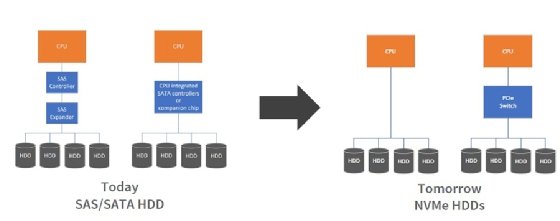
Getty Images
Seagate debuts NVMe HDD technology at OCP
Seagate demonstrated NVMe HDD technology, showing off its stability and its potential benefits. Customers can see a reduction in complexity and a step toward composability.
Seagate demoed HDDs running over the NVMe interface and expounded on the benefits such as simplification and consolidation of storage systems under just one interface at the Open Compute Project Global Summit this week in San Jose, Calif.
Customers could benefit from the new design, but not right away as the technology is in its infancy, according to industry experts. During Seagate's presentation, executives showed a prerecorded demo, presented with Microsoft, of HDDs running on the NVMe bus, for the first time publicly.
NVMe is both a host controller interface and a storage protocol. It is associated with SSDs and higher performance but can also be seen as enabler technology for storage composability and fabric connections to the host. With the release of the NVMe 2.0 specification in June of this year, the interface has been extended to HDDs. Seagate is hoping to be the first to ship the technology with its hard drives.
Ed Burns, research director of HDD and storage technologies at IDC, sees promise in the technology.
"It is exciting to see a vendor working with its customers to develop a technology that holds a lot of promise for reducing complexity and improving the ability to manage workloads," he said.
Still, he noted, it takes time for any market to adapt, and HDDs with NVMe are still a few years out for mainstream adoption.

NVMe isn't all about performance
David Allen, technologist in the office of the CTO at Seagate, said during the presentation, "Performance was not the main goal or the reason that drove this. It was about simplifying the stack."
Mohamad El-Batal, technologist in the office of the CTO at Seagate, echoed the point, saying the new NVMe interface is aimed at simplification and connecting to where the previous common HDD storage protocols, SAS and SATA, used to connect. The entire system will have a common interface, meaning bridging components, such as controllers and expanders for SATA and SAS and specialized drivers, can be removed, reducing complexity. The hard drives can be connected the same way as SSDs, either directly to the CPU or through a PCIe switch.
NVMe HDDs bring data centers closer to composability with the connection through NVMe over Fabrics (NVMe-oF), El-Batal said. NVMe-oF can take mass amounts of storage pools and make them available to component composers. With SAS and SATA interface, it would first have to be run through a translation layer, which is computationally inefficient and costly.
Another benefit of using NVMe with hard drives is better support for Seagate's multi-actuator technology, which provide the mechanism to read and write data to disks. Currently multi-actuator is on the SAS platform, El-Batal said. Some applications need two logical unit number (LUN), one for each actuator. With NVMe there is no LUN discovery, so the host doesn't need to search for the LUNs each time, making the process more efficient.
The final notable benefit to the drive is what Seagate calls tri-mode capabilities, meaning the interface is compatible with SATA, SAS and NVMe. Users won't have to choose a different product for different needs, it will all ship as the same SKU, with separate SKUs for single- and dual-port. The drives will be loaded with enablement of different interfaces through the firmware, El-Batal said.
Form factor and power
The new drives will still use the traditional 3.5" form factor, but the power requirements have been tweaked on the 12 and 5 volts, according to Jason Adrian, senior director of the Azure platform architecture at Microsoft. Whether the interface is PCIe Gen 3 or Gen 4 hasn't been set, he said. Support for Gen 4 is the goal, but the new HDDs will only need Gen 3, which will be the minimum supported.
Smaller power savings will come by removing SAS IOC and SAS expanders and replacing them with a single PCIe switch or directly connecting the HDD to the CPU.
Conceived as a nearline SATA and SAS replacement and more of an update on the interface instead of a new product category entirely, the NVMe HDD will have similar costs and power uses, El-Batal said. Being a replacement for SAS, the drive will have dual-port capability, which allows multiple hosts to connect to one device.
Not out, but ready to go
Engineering demo units of the HDDs with NVMe will be sent to key customers by September 2022, although these will be single port drives. By the middle of 2024, Seagate hopes to be shipping both single- and dual-port versions of customer demo units.
The new drives work with existing x86 CPUs and function with existing drivers, El-Batal said. There are also the 4088 rotational media that let the operating system know it is attaching to an HDD, not an SSD, so special drivers aren't needed for it to function.
As the technology matures, Seagate plans to target enterprises and accelerate GPUs, including possibly as an interface to mass storage and as a fabric attach for GPU direct, according to El-Batal.
Demand comes down to economics, IDC's Burns said. Reducing complexity and adding a commonality of components are attractive from a practical standpoint, but wide adoption will probably be seen when the price is more comparable to SATA.







